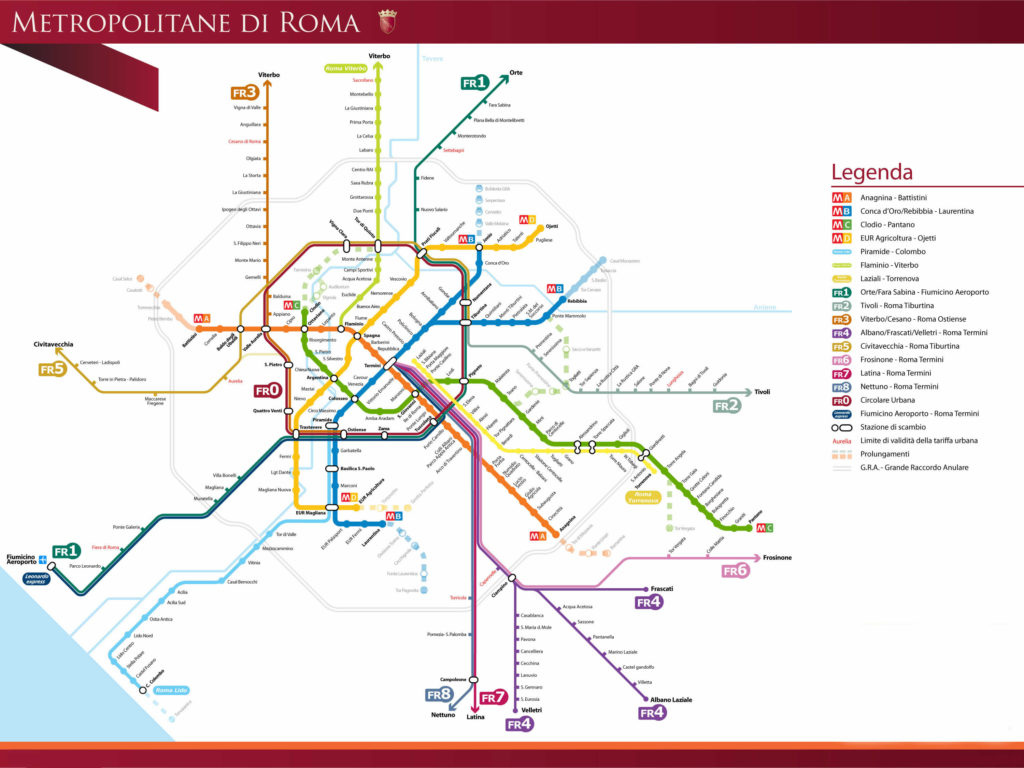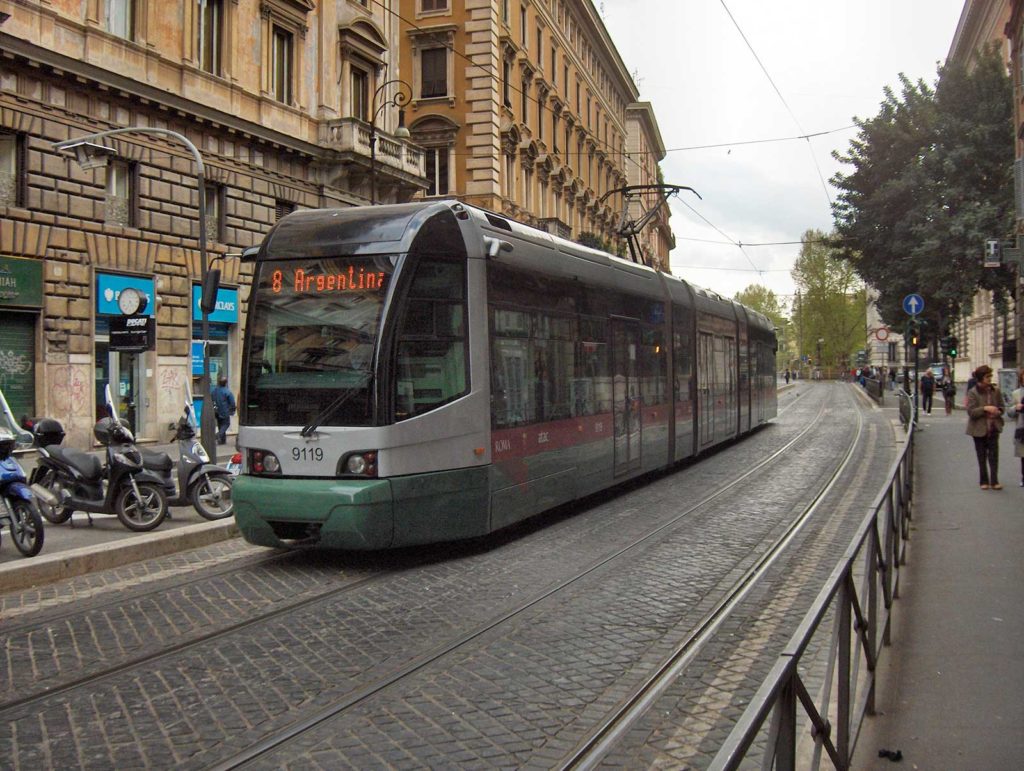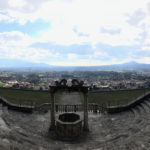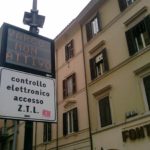The historic center of Rome is very walkable, but public transportation makes getting from one end of the city to the other much easier.
ATAC, Azienda per i Trasporti Autoferrotranviari del Comune di Roma, is Rome’s primary public transportation authority. It manages the wide network of metro lines, trams, and buses that moves thousands of locals and tourists in and around the city of Rome.
Rome transport tickets
A single ticket costs €1.50 and has a duration of 100 minutes. After stamping your ticket you can make as many transfers among many means of transportation as you like* before the ticket expires. Children under 10 ride for free.
You can purchase tickets from most Tabacchi (you’ll see the characteristic “T” sign outside their shop), a giornalaio (newspaper and magazine vendors on the streets), Rome info points, or at the ticket machines located in all metro stations.
Sometimes there is a ticket machine located on the bus or tram. These machines accept only coins and do not give change, so you must have the exact amount. Not all buses and trams have these ticket machines, and it’s common to find them out-of-service so don’t count on buying your ticket on board.
For buses and trams, carrying a validated ticket is based on the honor system. That is, it’s possible to get on a bus or tram without a ticket or without validating your ticket. ATAC officers conduct frequent checks on the busiest lines and will ask to see your validated ticket. If you don’t have one, you’ll face a fine of at least €50, payable immediately if you have cash.
*Your ticket can be used only once for the Metro. Switching Metro lines doesn’t require a second validation. You can stamp the ticket on a bus or tram and still use the already stamped ticket to enter into the Metro. Your ticket is also valid for the Roma-Lido train from Piramide to reach Ostia Antica.
Metro
Rome has 3 Metro lines:
- A (red)
- B (blue)
- C (silver)
The A & B lines intersect at just 1 station, Termini Station which is Rome’s main public transportation hub.
Line A
Stations (from North to South)
- Battistini
- Cornelia
- Baldo degli Ubaldi
- Valle Aurelia
- Cipro – to visit the Vatican Museums
- Ottaviano – to visit the Vatican
- Lepanto – to visit Castel Sant’Angelo
- Flaminio – to visit Piazza del Popolo
- Spagna – to visit Piazza di Spagna and the Spanish Steps
- Barberini – to visit the Trevi Fountain
- Repubblica – to visit the Rome Opera House, Piazza della Repubblica and Via Nazionale
- Termini
- Vittorio Emanuele
- Manzoni
- San Giovanni – to visit St. John in Lateran Basilica
- Red di Roma
- Ponte Lungo
- Furio Camillo
- Colli Albani
- Arco di Travertino
- Porta Furba
- Numidio Quadrato
- Lucio Sestio
- Giulio Agricola
- Subaugusta
- Cinecittà
- Anagnina
Looking for a vacation apartment along Metro A? Visit ROMAC and filter apartments by location to find rental that fits your needs! Search by map, too!
Line B
Stations (from South to North)
*Note: For trains traveling from Laurentina, there are 2 directions: toward Rebibbia and toward Jonio
- Laurentina
- EUR Fermi
- EUR Palasport
- EUR Magliana – to visit the Square Colosseum/Fendi and the EUR
- Marconi
- Basilica S. Paolo – to visit St. Paul’s Basilica outside the Walls
- Garbatella
- Piramide – to visit Rome’s Piramid, Montemartini Museum, or catch the train to Ostia Antica
- Circo Massimo – to visit Circus Maximus
- Colosseo – to visit the Colosseum
- Cavour
- Termini
- Castro Pretorio
- Policlinico
- Bologna
- Toward Rebibbia
- Tiburtina FS – to catch a train from Tiburtina Train Station
- Quintiliani
- Monti Tiburtini
- Pietralata
- Santa Maria del Soccorso
- Ponte Mammolo
- Rebibbia
- Toward Jonio
- Sant’Agnese/Annibagliano
- Libia
- Conca d’Oro
- Jonio
- Toward Rebibbia
Looking for a vacation apartment along Metro B: visit ROMAC and filter apartments by location to find rental that fits your needs! Search by map, too!
Line C
Stations (from South to North)
- Monte Compatri – Pantano
- Graniti
- Finocchio
- Bolognetta
- Borghesiana
- Due Leoni – Fontana Candida
- Grotte Celoni
- Torre Gaia
- Torre Angela
- Torrenova
- Giardinetti
- Torre Maura
- Torre Spaccata
- Alessandrino
- Parco di Centocelle
- Mirti
- Gardenie
- Teano
- Malatesta
- Pigneto
- Lodi
San GiovanniAmba AradamFori ImperialiVeneziaChiesa NuovaSan PietroRisorgimentoOttavianoClodio/Mazzini
The C line in the historic center is still under construction, it is only useful for tourists wishing to visit the periphery. Also note that none of the operating stations intersect any of the stations of lines A or B.
Trams
Rome’s tram network is extensive which makes reaching longer distances not serviced by the Metro much more convenient. Areas like Trastevere (Trams 3 & 8) and around Villa Borghese (Trams 3 & 19) are much easier to reach thanks to the Tram system.
All of the trams are above ground which also gives the opportunity to enjoy the scenery, which on most lines is really quite spectacular. In fact, if you’re looking for an inexpensive way to view many beautiful parts of Rome from a window seat, hop on Tram 3 at Trastevere Station and take it all the way to Villa Borghese. You’ll pass through the entire historic center in about 25 minutes with a really spectacular view along the way.
Transportation Strikes
Unfortunately Rome’s public transportation is susceptible to employee strikes – often at the most inconvenient times. Called Sciopero in Italian, a strike will effectively shut down the metro, trams and/or buses for most of the day when they occur. Every strike is different, so for the most up-to-date information check the official ATAC website to find out what lines are participating and the time of day there won’t be service.
Download the app Moovit which will send you push notifications about strikes, closures, or delays. When there is a strike, the only reliable transportation is a private taxi.
Have you taken public transportation in Rome before? Share your experience with us in the comments below!




















[…] the same as a city metro/bus ticket (cost €1.50, for more information read our blog post about taking public transportation in Rome). Get off at the Ostia Antica […]
[…] system (bus, metro, tram) for the duration of the pass’s validity (see our blog post on public transportation in Rome for getting around the […]
[…] itinerary utilizes the metro to get around quickly, so have a look at our post about the Rome public transportation if you’re unsure how the metro in Rome […]
[…] You can find more information for taking the Rome metro and getting around the city from our blog post on taking Rome’s public transportation. […]
[…] If you’re less interested in visiting museums but would like to information on getting around the city with public transportation, check out our post on taking Rome’s metro, trams, and buses. […]
Public transportation, especially the metro is very convinient, but we prefered walking in our previous tripsnto Rome but we stayed mainly in the center. So if you wanna go a little further try the tram, which is what we ll do in our next trip… Enjoy Rome by walk, tram, bus, metro, taxi whatever…